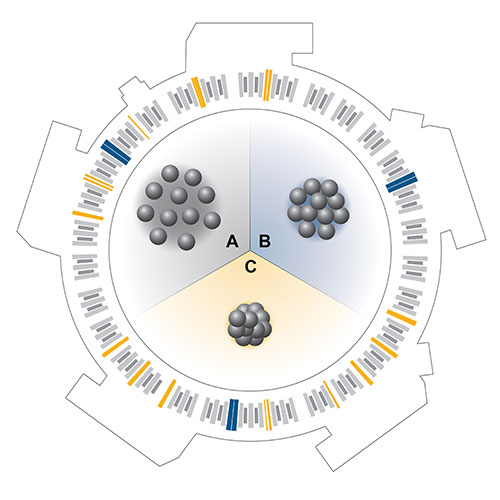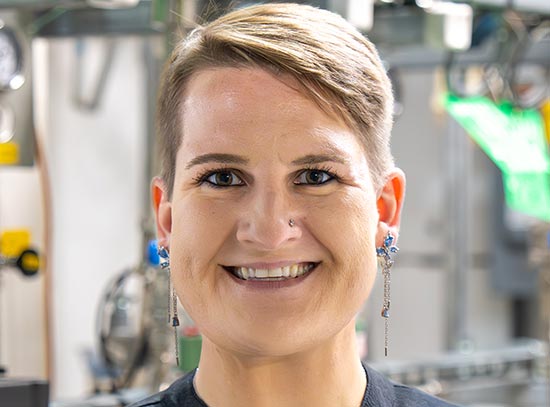Optimizing the NSLS-II Beam Parameters
NSLS-II's scientists calibrate the particle accelerator to ensure high quality x-rays for world-class research
May 31, 2020
 enlarge
enlarge
Three different lattice versions and corresponding beam sizes at NSLS-II: A) magnet optics (gray), B) with damping wigglers (blue), and C) with all insertion devices (yellow). Image credit: V. Smaluk et al. Phys. Rev. Accel. Beams 22, 124001
The Science
Scientists studied three essential beam parameters of the NSLS-II storage ring.
The Impact
To ensure high beam quality for users at a synchrotron light source, scientists need to measure, model, and optimize the main beam parameters of the accelerator.
Summary
From new cell phone batteries to prescription drugs, researchers use x-rays to understand all kinds of materials and life around us. As a Department of Energy Office of Science User Facility, the National Synchrotron Light Source II (NSLS-II) runs an 800-meter-long particle accelerator to generate ultrabright x-rays dedicated to a wide variety of research areas.
However, running a machine as advanced as the NSLS-II requires a deep knowledge and understanding of the complex behavior of the electrons orbiting within the accelerator. Therefore, the scientists at NSLS-II also study the behavior of the accelerator very closely. They optimize and upgrade the machine to increase x-rays brightness and calibrate the sources by comparing measured beam parameters with calculated theoretical values.
In this study, the team explored three essential parameters of the electron beam: emittance, energy spread, and radiation energy loss. Out of these three, beam emittance and energy spread are highly relevant for all experiments using NSLS-II’s x-rays, while energy loss per turn directly translates to megawatt-level load on the ring’s radiofrequency (RF) systems. During the original design and commissioning of NSLS-II, the accelerator consisted of its magnetic optics, also called the lattice, three damping wigglers, and six insertion devices. Both the damping wigglers and the insertion devices generate x-rays for scientific experiments, but also influence the electron beam parameters.
So, during commissioning the scientists measured and calculated the beam parameters for two configurations: the “bare” magnetic lattice without the damping wigglers and the magnetic lattice with the damping wigglers. Since these initial calculations, the facility installed another 11 insertion devices into the storage ring, which also affected the electron beam and therefore, changed the light source’s performance. The team repeated the measurements and calculations for three accelerator configurations: A) the bare lattice (no wigglers and insertion devices), B) the lattice with only three damping wigglers, and C) a lattice with all insertion devices. They calculated the theoretical values to compare their results from the measurements and simulations. For these measurements, the team used the NSLS-II optical diagnostics and the Coherent Hard X-ray (CHX) beamline. To fully comprehend the measured parameters and compare them with the theoretical values, the team simulated the behavior of the x-rays and the electrons using the Synchrotron Radiation Workshop (SRW) code.
As a result of this detailed calibration, the team measured the following values for the emittance of the three configurations: 2.05 nm, 0.92 nm, and 0.76 nm, respectively. The measured values of the emittance, radiation energy loss, and energy spread showed a good agreement with analytical formulas and numerical simulations. These measurements and calculations will help the scientists to ensure high up-times and high-quality x-rays for the over 28 different experiments running in parallel at the facility.
Download the research summary slide
Contact
Victor Smalyuk
National Synchrotron Light Source II
Brookhaven National Laboratory
smalyuk@bnl.gov
Publication
V. Smalyuk, Y. Li, Y. Hidaka, T. Tanabe, O. Chubar, L. Wiegart, A. Blednykh, B. Bacha, T. Shaftan. Effect of undulators on magnet lattice and emittance. Phys. Rev. Accel. Beams 22, 124001. DOI: 10.1103/PhysRevAccelBeams.22.124001
Funding
This work was supported by DOE under Contract No. DE-SC0012704. SRW code is partially supported by DOE SBIR Grant No. DE-SC0011237 and DOE BES Field Work Proposal grant on “New Capabilities for Simulation of Coherent X-ray Scattering Experiments at Light Sources”.
2020-18947 | INT/EXT | Newsroom









